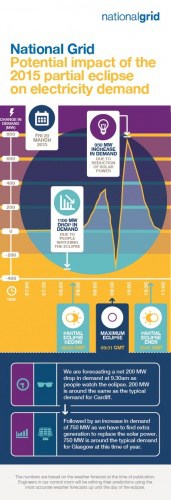According to National Grid’s forecasting team this will be largely offset by an 1100MW drop in demand for electricity as people as people go outside to see view the phenomenon.
The net effect of the eclipse will be a 200MW drop in demand at 0930 as people watch the eclipse.
Jeremy Caplin forecasting manager at National Grid’s said: ‘We started planning for this in May last year and have a range of tools in place to manage any effects of the eclipse and balance the network, including demand side services and extra generation.”

He told National Grid’s Connecting: “We expect there to be a significant suppression in demand when the eclipse starts, followed by a pick-up when people start to go back inside. The extent of the pick-up will depend on the weather. If it’s sunny, we’re expecting a 1700MW surge. If it’s an average day, it will be more like 1000MW. The cloudier it is, the less of a swing we’ll see.
“We’ll be plotting against the most accurate weather forecasts and refining predictions all the time the closer we get to the eclipse.
Solar energy, a relative newcomer to the energy mix, will be lost during the celestial event, a situation National Grid has prepared for.
Caplin said: “If things go as we have predicted, there will be an 1100MW drop in demand due to people watching the eclipse, offset by an increase in demand due to the loss of power generated by solar units. The net effect of the eclipse is forecast to be a 200MW drop in demand at around 0930 in the morning as people watch it.
“Then we have to factor in the extra generation we need to find to replace the solar, which won’t be back to normal until 1030. It’s such a complicated scenario, with a range of variable due to the weather, which is why our forecasting team have spent such a long time planning.”
A total solar eclipse happens when the Moon’s apparent diameter is the same as or larger than the Sun, blocking all direct sunlight, turning day into darkness. Totality can be seen in a narrow path across the Earth’s surface, and a partial solar eclipse will be visible over a region thousands of kilometres wide.
On 20 March, the shadow of the Moon will move over part of the Earth, as it passes directly between Earth and the Sun. With the Moon obscuring over 80 per cent of the Sun as it passes by, the penumbra will be visible.
Total solar eclipses in the UK are rare astronomical events. Despite occurring somewhere on Earth every 18 months on average, it is predicted that they recur at any given place just once every 360 to 410 years, on average. Solar eclipses can only occur when the Moon is near the nodes (the intersection of the orbital plane of a celestial body) of its orbit at New Moon when it lies between the Earth and the Sun and the shadow of the Moon can then pass over the surface of the Earth. The next total eclipse visible in the UK will be 23 September 2090, but the next similar partial eclipse will be visible on 12 August 2026.
Source: Royal Observatory





Poll: Should the UK’s railways be renationalised?
I think that a network inclusive of the vehicles on it would make sense. However it remains to be seen if there is any plan for it to be for the...